Text
The Impact of the Work_ Written a Year Later
For almost a year now, this production has still been occupying the top spot on video sites for related terms. Ultimately over 1.4 million people have watched the video and many of them have written their own reflections on the research question. These insights have guided my subsequent research well and have enlightened me on some of the gaps I had not yet researched. I could say, this is the greatest achievement I have made since applying Practice as Research (PaR) as a research methodology.

Two months after the release of the video, I was approached by a number of self-publishers and official media to interview me and promote my research. I was grateful for this and agreed to several interviews. The number of views on these interviews was impressive and further explained to the public the difference in behaviour between the real and virtual worlds. Below is a screenshot of an interview with a Chinese media outlet, which eventually received 25.6k views (Available at: https://mp.weixin.qq.com/s/Zl6EMpsl2Jy4XLo2aWO5pw).

In addition, with the influence of the video, I have formed a China-wide community that uses VR Chat to research various topics in the virtual world. As of today the community has reached 939 people. I hope that in the future this community will be joined by more artists, academics, lecturers, etc. to promote cutting-edge digital media research (especially for VR Chat, Horizon Worlds metaverse platform), just as my predecessors did for Second-Life 15 years ago.

0 notes
Text
Feedbacks from Supervisor
The work ended up with a high score of 79, however, there was a 5% deduction because I misremembered the submission time (SO SAD).

I was very inspired by the professor's comments, which are reproduced below for ease of reference.
Feedback
Experimentation and inventiveness
The very concept of this networked performance is inventive and its approach is experimental. You have started the process to doing this networked performance with a combination of a specific interest in using a 3D space and an open mind to where that might take you. The performance is very successful but I do feel there is more to investigate here and you should follow through on this i.e. different technical configurations, different scenarios in-world designed to encourage interaction with you, different visual perspectives of what is seen in both spaces, by you, by others or as a mixed reality etc.
Realisation, technique and technology
The realisation of this work demonstrates a strong understanding of the relationship between the use of technology, understanding how it works and then, building on that knowledge, what it affords in artistic practice. There is a serious and clear line of investigation in practice here, in a sense this is practice as research (PaR) but you have also managed to incorporate aspects of irreverence and comedy to engage the audience. Reading, for example, is comical. Such a simple task in reality, which in this performance results in an oddly distorted avatar that provokes users to question what is happening. This is not alone a good example of what live performance can uncover, that situations can be unique and performed to in a responsive way, but that when combined with technology can yield some surprising responses. However, while the ‘reading scene’ works well scenes such as dining are less successful because the users largely ignore you and congregate behind you. I wonder if they have grown used to your avatar’s contortions, perhaps they perceive it as a glitch/bug? This is a good learning experience to see what works and what doesn’t.
Understanding of spatial and temporal relationships
There is a good sense of time in this performance in how you have segmented and explained your day e.g. morning exercise, reading, dining etc. This may not be apparent to the audience in-world during the performance but is very apparent so to those who will watch it later as an edited video. You have effectively thought about your two audiences! The sleeping scene (also hilarious but becomes a little sinister – slapping, swearing, sitting on your face etc.) also plays with time as subject in a clever way. It is unexpected in a ‘virtual’ world – why does an avatar sleep? But ‘we’ do so why not! And does that mean that there should be a night in ‘virtual’ worlds? These are all clever time-related questions. I do recommend that you look at some performance art that use simple scenarios like this e.g. Pose Work for Plinths by Bruce McLean and Plank Piece by Charles Ray. Thinking about how the space of VR chat influences some of your scenes/actions in that space could also be considered.
Communication and presentation
The introduction to your performance works relative well. You are articulate in how you explain the idea of the performance and you frame it effectively as an experiment (“How well will it turn out? Let’s wait and see.”). The display of the text is a little too short to fully read. The subtitles seem to be very selective as to what is translated. It is necessary to translate everything because everything would seem to be appropriate i.e. what you are reading, talking about etc. but also what users in-world are talking about.
Crew or curating: Peer assessment
Well done for completing the peer evaluations for your team members with such a serious attitude (some of the best written feedback I have seen). Unfortunately, they will not see it – there is simply no way for me to feed it back to those students and maintain anonymity for you as their assessor. This does not mean their grade has been adversely affected – it hasn’t. Your team members reported very positively on your crewing of their performances. They stated you were very supportive and assisted well during the live performances.
You have submitted both peer assessments and the networked performance approximately two hours late – what happened, did you think all three deadlines were the 22nd? This is very unfortunate – particularly for such a strong networked performance!
Networked performance and peer assessments submitted one-day late – -5%
Also, Some Comments were made to my Proposal.

Feedback
Proposal: Research application
Your proposal demonstrates good research and applies this well in how you discuss the idea, how you consider where you are (in both spaces), where the audience will be (during and after – the video) and how you will capture documentation. These aspects of your proposed networked performance are well on their way to being very clear and should (with some further development) come together into a very effective performance.
Proposal: Clarity
There is strong clear idea contained in your proposal, however, it does need some reflection and further development as it is packed in with some other ideas that are diluting its potential. The idea of seeing one space while you interact within another (a split presence) is very simple and will immediately be understood by an audience. You are effectively separating your senses and making a statement about how we inhabit these spaces and technologies through different senses. This is very elegant as an idea. The evaluation of the actual interactions you perform is less important – these are simply the occurrences in the performance, a means to an end. The hazards the performance might contain are not a disadvantage but in fact true to the reality of the situation and you should try to work with them.
Second Marker’s Feedback: Upon review of the assessment, I agree with the first marker’s feedback and evaluation.
Digital Sketchbook: Research
Your use of your Digital sketchbook is not regular and evenly distributed across the module. It starts on May 3rd, which is already over two months into the module. I appreciate that you had issues with your initial Digital Sketchbook and were required to change but why did this occur so late? Understand that the sketchbook is intended to be used regularly so that it functions as a research and planning space/tool. Research and planning is not something you do at the end of the module (or all at once at any point during the module) nor is it something you do in retrospectto having made your project decisions and/or completed your project. This said your sketchbook is very good. Don’t worry about perfect phrasing or even complete/articulate sentences – write freely, it’s not an essay. Your understanding of networked performance is excellently demonstrated and there are some strong examples of practice that pick up ideas in lectures combined with your own interests. Your identification of platforms as a ‘space’ to perform is excellent – VR chat for example, a very controversial space hosting a lot of extreme right-wing users, is a ‘space’ that calls out for further exploration. You state “with today's metaverse mindset, virtual communities have become very different. People choose to enter virtual communities in large part because it is possible to dispense with the rules of the real world.” - you may be very surprised how little has actually changed since the time of early online communities. I strongly recommend you read Sherry Turkle’s book Life on the Screen as a historic overview of how little has changed while technologies have become more complex.
Digital Sketchbook: Planning
Your planning is overall very good. You have written about all of your technical issues, solutions and work arounds very well and there are many images documenting these processes. Well done for thinking about optimising the performance of your computer, lowering unnecessary 3D rendering features that probably wouldn’t be visible in the final recording anyway. Don’t forget about lowering the webcam quality, however. You are displaying the webcam video at a small size so the video captured from the camera can be turned right down (probably to 640 x 480 pixels – no need for HD here). That will also speed things up and reduce the risk of any app crashing due to memory. Overall a very good/strong Digital Sketchbook – well done!
0 notes
Text
Follow-on Additions
After the live performance, I uploaded the most interesting part(sleeping) to Bilibili. The clip, which I titled "When You Really Fall Asleep in VR Chat", was a surprise hit, attracting over 182,000 viewers within 5 days. Over 350 comments and 250 pop-ups were made on topics related to this networked performance. However, most of them are in Chinese, so it is difficult to translate them for Garrett. But these huge numbers already illustrate how my performances fit into the contemporary internet context. I am proud of my networked performances.

If you would also like to watch it, you can do so via the link below:
Finally, thank you again, Garrett, for bringing me up to speed on networked performance.
0 notes
Text
Acknowledge
First of all, I would like to thank Garrett, whose lectures gave me my first impressions of networked performance. Each of his tutorials has helped me to refine my plans in the development of my own project. I am also grateful for his understanding and encouragement during the DDL extension, which helped me to regain confidence during my isolation.
After that, I would like to thank my childhood friend, Letian Ding, who accompanied me for 8 hours as my assistant, helping me to adjust the camera, confirm the recording and so on.

Meanwhile, I would like to thank all my team members(Shiqi Cai, Jingyao Wu, Xiongju Sun) who played a very important role in my performance. My performance was the longest of all my classmates, so I needed the most effort from my team members to present the piece perfectly. However, they didn't resist in the slightest, but eagerly offered to help me, for which I am very grateful. I would also like to thank all my audience, both 'virtual' and 'real', whose feedback was very significant to my work. Finally, thank you to the whole world! I've finally finished my networked performance!

0 notes
Text
Reflection of My Networked Performance
From the perspective of project itself:
The project has been an overall success. I completed the 8 hour performance without any mistakes or incidents.
For my purpose: to explore and represent the differences in behavioural habits between the real world and the virtual world(in other words, what will happen if a real person live in virtual world use real-life behavior), this performance was presented very well. Especially during 'Sleeping', the virtual audience tended to think in the direction of 'dead' and 'posing', which led to their reactions being very funny to my This resulted in their reactions looking very funny to my real audience.
Most of my real-life actions don't really attract much attention, except for sleeping, which is almost impossible to do in a virtual world. I think this is still due to the fact that the virtual world is not completely divorced from the real world.
The downside of the project is that 80% of the time it was just me in the virtual world, which took away the value of many of the actions I expected to get a lot of feedback on. This is something I need to focus on for the next performance(IF HAVE).
From my perspective as a performer:
Eight hours of performing left me totally exhausted. The weight of the VR headset and the glare of the screen left me in a state of prolonged dizziness after the performance. This made me realise that META's idea that "people would get used to spending their days in the Metaverse" is almost impossible to achieve, at least with the current state of technology.
Furthermore, while wearing VR headset enhanced my abilities in some sensory, they did also hinder them in more ways than one.
Although I have turned the VR Headset into AR mode by some means. However, I still could not clearly distinguish the objects in front of me, resulting in many restricted actions. For example, it is difficult to turn pages when reading a book, or to use cutlery when eating, etc. Thus, virtual reality is more like a double-edged sword; the more you desire to delve into the virtual world, the easier it is to get stuck in the real world.
0 notes
Text
Participation in Others Performances
These past few weeks have seen a flurry of networked performances from my classmates. Unfortunately, I happened to be quarantined during this time and the internet speed in the isolated hotel was hardly able to support me to watch the performances smoothly. However, I did my best to participate in each of the performances, posting comments and pop-ups to give them feedback as much as I could.
I also tried my best to help my team members with their performances. I acted as the live administrator for Shiqi Cai's performance and became the main audience for Jingyao Wu's performance. I hope my help could be useful to them.
0 notes
Text
Production Process 9: Post-production for Exhibit
Having finished the networked performance and acquired the eight hours of recording, I start to think about how it could be edited to fit better into the context of the exhibition.
The solution previously discussed with Garrett and appreciated was to fast forward the useless bits and keep the highlights to make a video of around 20 minutes in total. This would ensure the viewer's experience in the context of the exhibition.
However, when I started editing, I realised that this would be problematic: an 8-hour video would need to be accelerated 24 times to condense it to 20 minutes, which would result in the accelerated sections becoming very fast and dizzying. This is clearly not a good option.
So, I took a bolder approach. I cut out the useless parts straight away and kept a few of my main actions (reading, morning exercise, eating, sleeping). Although this will somewhat weaken the "Time" element of my work, it will greatly enhance the experience of the viewer. In addition, I have translated all the Chinese content in the video for the benefit of the English speaker and made it subtitled to help the viewer understand.
The audience experience is the most important thing!

1 note
·
View note
Text
Production Process 8: Official Performance
On June 16th, I did my official performance. The performance began at 9:00 A.M. and ended at 5:00 P.M.. The whole performance went very smoothly with no technical errors.
Slightly unfortunately, I forgot to ask my assistant to take some photos for me to put in my sketchbook. My webcam recorded enough of them, though.
0 notes
Text
Production Process 7: Pre-rehearsal & Rehearsal
An important issue has suddenly arisen the day before the rehearsal:
My VR headset always relies on the Oculus APP to work. However, the day before the rehearsal, the Oculus on the PC side updated automatically, while the VR headset side did not (because it needed to link to a network outside of China). Such software version inconsistencies lead to my headset not being able to be linked to the PC and I was unable to do my performance.
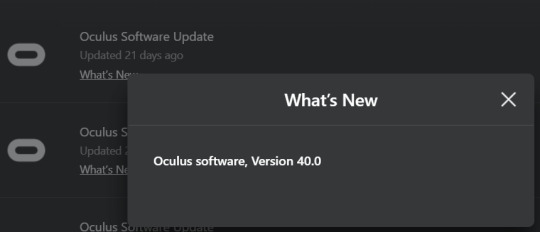
I was helpless, but I didn't give up. I asked questions on Google & the Oculus forum, and found a way to build an offshore virtual network to do updates. Through the method, I eventually finished the update on the headset side and was able to get the rehearsal to go ahead as planned.
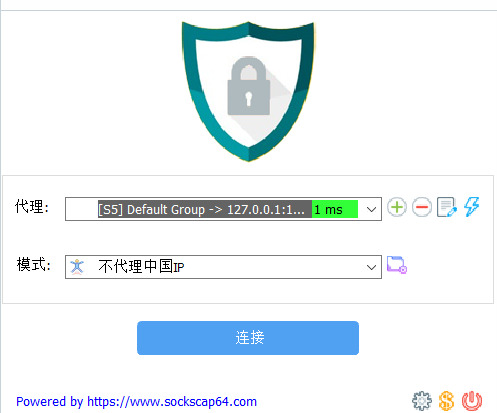
Although this issue has nothing to do with the content of my networked performance, I thought it was important to document it. This process taught me that when preparing a networked project, it is not only necessary to consider how to modify the subjective design, but also to anticipate possible surprises with objective objects(Equipment breakdown, Network disconnection, etc.).
Rehearsal:
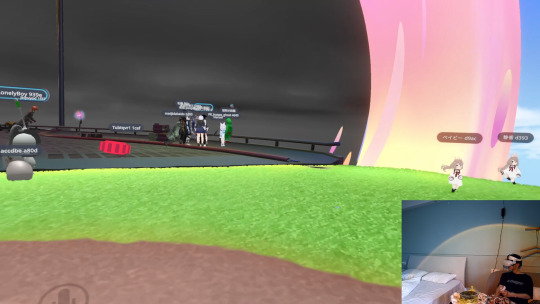
On June 15th, I did my rehearsal for four hours.
My real-life assistant was involved for the first time, simulating the actions that would take place during the performance (moving the camera, detecting the effects of the recording, etc.). In addition, members of my team were invited to come into the live room to manage the comments section. And in the virtual world, I got a first feel for the behavioural tendencies of the players. This helped me to better modify the range of behaviours I was about to do in the virtual world. All in all, the rehearsal went well.
0 notes
Text
Production Process 6: In-game Optimization
After a series of tests, I realised that some optimisations needed to be made in the VR Chat:
Avatar: The avatar used in tests were not sufficiently detailed, which led to a lot of model overlaps. Additionally, the bone & skeleton binding is also poorly done, resulting in non-corresponding motion capture effects.
Therefore, I use an official plugin called ReadyPlayerMe to re-create my avatar. As well as using face scans, I also scanned the whole body to better achieve the effect of "Real Me". The final result is pleasing: there is no more model overlaps and the motion capture effect is excellent(Even capable of finger-accurate simulation).




PC Performance Optimisation: After some testing, I found that my computer was struggling to cope with so many applications (VR Chat + Oculus + Live Camera + OBS + Bilibili Live) at the same time, so it was imperative to optimise performance, with VR Chat being the most important part. As the illustrations show, I have done a lot of simplifying(Abandon Dynamic Bones, Blocking Visual Effects, Graphics Quality, etc.)


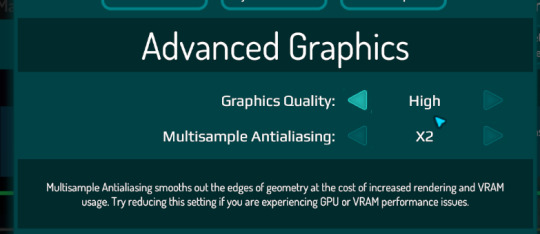
0 notes
Text
Production Process 5: Live Streaming Attempt

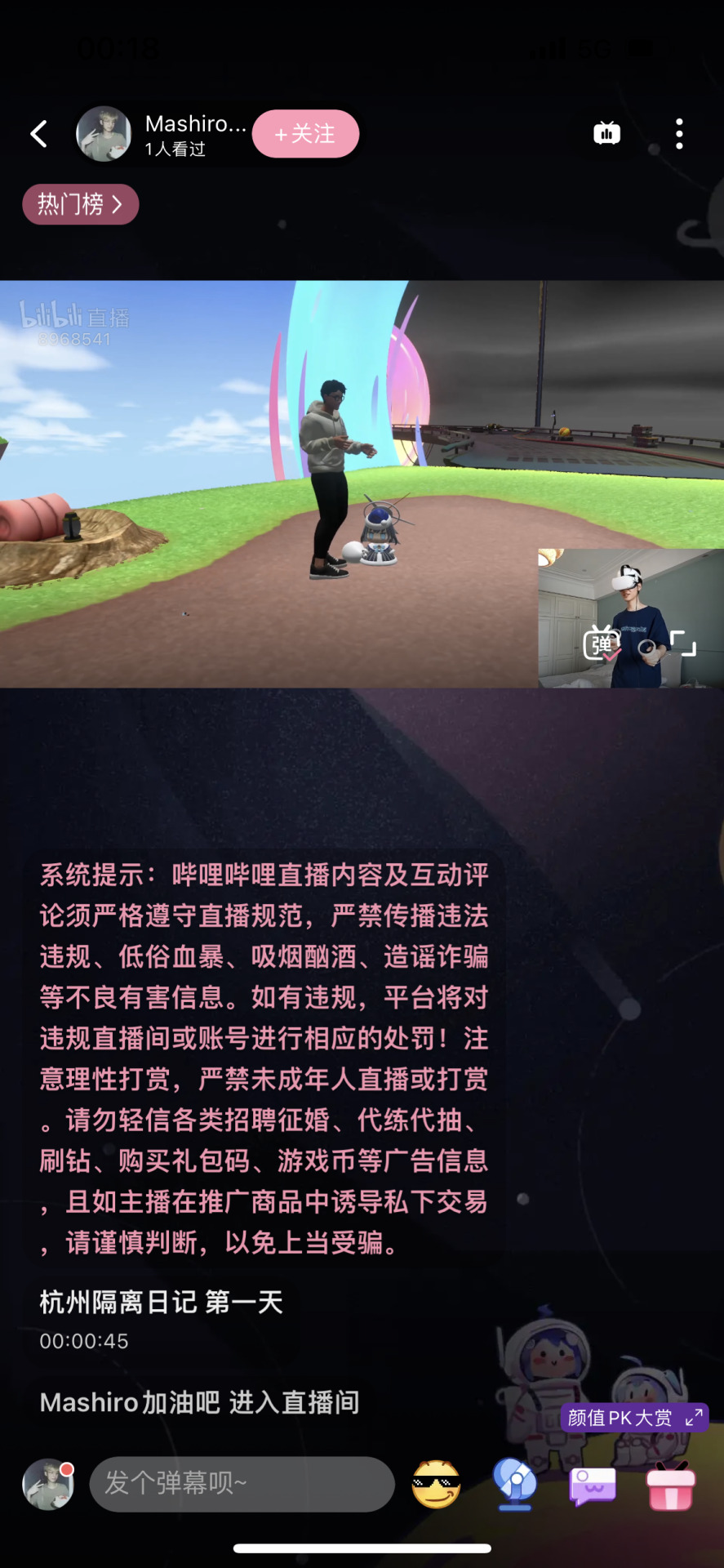
After completing the OBS setup, I made a short attempt at live streaming. This test confirmed that the sound, video, etc. worked correctly.
0 notes
Text
Production Process 4: Integration within OBS
The need for OBS in my project is actually very simple: one source records the VR Chat frame and the other source records the real-life footage. This can be easily set up:
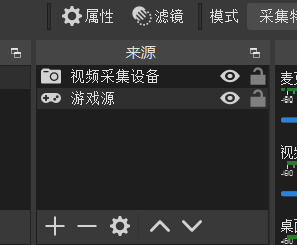
However, there are still some settings in OBS that I need to be aware of. Firstly, being an eight hour long recording, I needed to reserve the file space in advance and set the appropriate bit rate to ensure that the file size was not too large (under 100G was acceptable). This is my final setting.

Additionally, since the VR Chat and my voice are in different audio tracks, I need to integrate them together. But the problem is, VR chat's audio is played on my Oculus Quest so it cannot be record if using default preference. Therefore, I changed some settings.

Finally, as this is a video recorded in VR, stereo sound is necessary instead of mono.

With this OBS setup, the conditions required for the performance have basically been met.
0 notes
Text
Production Process 3: Live Camera Setup
The real-life Camera carries the responsibility of live streaming my body action. Based on my tutorial with Garrett, I decided that a wireless camera would be the best option, as it could be conveniently fixed at a higher position to record over a wider area. However, the wireless Camera often have transmission latency issues, which I will have to test to confirm.


The results of the test were not to my satisfaction. There were three main problems:
1. The frame quality was poor compared to the wired camera, and I can only monitor it through my phone rather than my PC.
2. There was a chronic delay of about 1s-2s, which would make the action in reality seem disjointed with the action in VR Chat when live.
3. the wireless camera needed to take up internet speed, and I already had many essential items that took up internet speed (VR Chat, Bilibili Live). This caused the whole internet performance process to be laggy.
Therefore, I ditched the wireless camera in favour of a wired one. The wired camera has been tested and is able to solve the latency problem very well (delay within 0.5s, which is an acceptable level). In addition, it does not require internet speed, but transmits directly via data cable. The only drawback, however, is that the cable is not long enough, which makes it difficult to place it in a very high position to overlook the whole room. As a result, I may needed an assistant to manually adjust the camera position during my official performance to ensure that I was in frame the whole time.



1 note
·
View note
Text
Production Process 2: In-game Camera Setup
VR Chat has a built-in camera to record third-person views. However, I have to say setting up this in-game camera is extremely tough! The camera is only available when using the VR version, so I had to use both hands to adjust the angle bit by bit...And once the camera is fixed, I can't monitor what's in the frame (as in the third picture). If I want to see it, I have to go behind the camera, which is very inconvenient… So I need an assistant to watch me in the frame at all times and to remind me when I'm about to step out of the frame.
However, the in-game camera is generally satisfactory. It has high definition and also a high frame rate for live streaming and video.



Updated after in-game optimization:
I am now more proficient in the use of the in-game camera. In this video, I have hidden the camera frame and tried to record a segment.
0 notes
Text
Production Process 1: Intro Video
I'm finally out of medical isolation! Officially getting ready for my performance!
In my expectation, the realistic audience is aware of what I intend to explore with this performance. But how do I let them know? Getting my crew to help answer questions in the live room could help, but the pop-up area is definitely not a Q&A forum and would inevitably cause confusion. As such, my solution is to record an intro-video and play it at the very beginning of my performance, which not only acts as a warm-up but also enables the audience to understand my intentions right from the start. I will also upload this video to my Bilibili so that subsequent audience coming in will be able to see it at any time.
P.S The official performance changed to June 16th.
0 notes
Text
Case Analysis 7 (We Met in Virtual Reality)
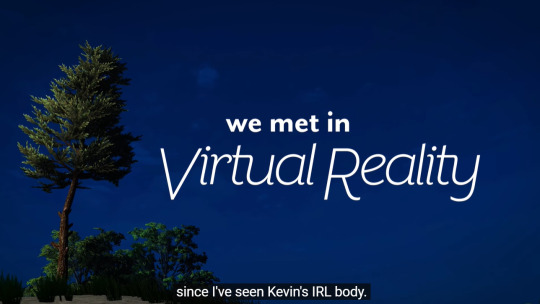
Another excellent work by Joe Hunting is We Met in Virtual Reality. Filmed entirely within VR Chat using a cinematic virtual camera during Covid's lockdown crisis, this feature-length documentary showcases users' emotional impressions of this immersive world through a poetic collage of stories. At the same time, it explores how VR affects users' socialisation, love and self-expression.

This documentary chronicles the lives of many VR Chat users and why they joined this virtual community. Some people deliberately come to VR Chat to become a dance instructor in order to be totally different from their real selves. Besides, some deliberately come to VR Chat to make sign language instruction available to more people like a missionary from the real world. However, there are also people who have to come to VR Chat just because COVID makes it impossible for couples to meet in reality.
In conclusion, in VR Chat, there are people who are "completely virtual", people who are "between virtual and real" and people who "represent reality but are temporarily virtual". I am looking forward to getting different comments from these three types of people (As my virtual world audience) in my internet performances, which will be very interesting and contradictory.
P.S. With this documentary, I finally understand what the [IRL] after Garrett's name means. If I'm not mistaken, it means "in real life" :)
REF. Sundance Institute (2021) Meet the Artist: Joe Hunting on "We Met in Virtual Reality" [Online Video] available at: https://www.youtube.com/watch?v=WSNJUngJ_fQ
Sydney Film Festival (2022) We Met In Virtual Reality – Trailer – SFF 22 [Online Video] available at: https://www.youtube.com/watch?v=EyMSEuwgbZ0
1 note
·
View note
Text
Case Analysis 6 (Virtual Speech Panel - Raindance Immersive 2020)
Since I decided on the medium of performance as VR Chat, I have been searching for internet performances that have taken place in this virtual community for reference. It's not an easy process, as virtual communities and games are not a common canvas for artists to showcase their talents. Luckily though, I was able to discover a talented artist named Joe Hunting and his artworks.
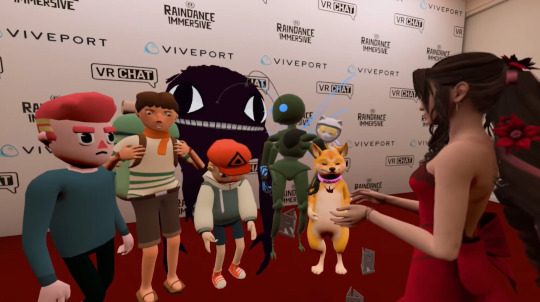

Virtual Speech Panel - Raindance Immersive 2020 is the first piece of his artwork interested me. In this piece, Joe Hunting invited many of the pals he met in VR Chat (Although he had only seen their avatars and had never seen these people in the real world) during the epidemic to join him in this virtual speech. These pals will do their pleases to provide their opinions on various different real-world topics(e.g. Love&Romance, Animals, Power&Fame, Lockdown, etc.) as their virtual avatars and virtual settings.
The performance lasted 30 minutes, but I didn't feel it was too long, with Joe Hunting acting as a moderator to guide the speech. The Virtual Avators' answers to real-life questions were utterly different from those of real people, which reinforced my belief that there has already a stark difference between real-world behaviour and virtual-world behaviour. Besides, they talked about the many points where the virtual and the real intertwine, which was very interesting.
However, I think the performance is still flawed in its design of the relationship with the audience. In VR Chat, there is actually no audience for the entire performance as it happens. Instead, the audience is allowed to watch the performance only after being edited and uploaded to Youtube. This is a pity because it only considers the idea of having real-world viewers evaluate virtual avatars' opinions, but not the evaluation of those opinions by other players in the virtual world.
My modification would be to welcome the audience to listen to the speech in VR Chat as well, just like a talk show in reality. I'm sure the audience in the virtual world would react in many different ways (e.g. audience engrossed in the virtual world might agree with what these people are saying; players who are just here to experience the virtual world might get argumentative). This would make the whole performance more random and suspenseful.
REF. Joe Hunting (2020) Virtually Speaking Panel - Raindance Immersive 2020 [Online Video] available at:https://www.youtube.com/watch?v=yx6o4rrHbtg&t=889s
0 notes